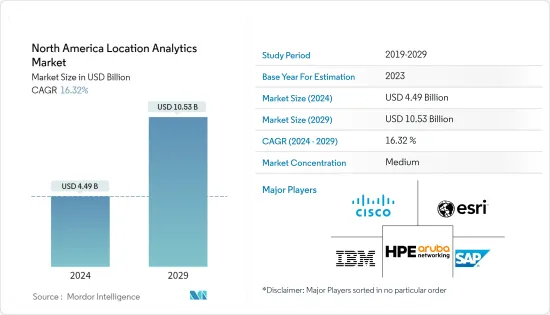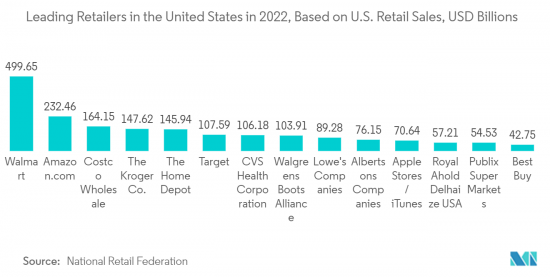PUBLISHER: Mordor Intelligence | PRODUCT CODE: 1403041

PUBLISHER: Mordor Intelligence | PRODUCT CODE: 1403041
North America Location Analytics - Market Share Analysis, Industry Trends & Statistics, Growth Forecasts 2024 - 2029

The North America Location Analytics Market size is estimated at USD 4.49 billion in 2024, and is expected to reach USD 10.53 billion by 2029, growing at a CAGR of 16.32% during the forecast period (2024-2029).
Geospatial services have been increasingly favored by different sectors, including retail, government, health care, and industry, over the last few years. Cloud computing (IoT), blockchain, and artificial intelligence are expanding the applications of location analytics and, as a result, driving the market.
Key Highlights
- The market is significantly driven by the GPS (Global Positioning System) practices in smartphones, vehicles, and other portable devices. Mobile positioning combined with satellite-based GPS is the most rapidly developing method of positioning. The practical accuracy ranges from 50 to 1000 m for methods such as global cell identity CGICTA and an enhanced observed difference of time, EGOTD. These technologies provide end-users with opportunities based on the accuracy required for specific application location identification.
- The United States boasts various GPS infrastructures, such as satellites, equipment manufacturers, and supportive research funding, combined with government support to boost the technology's penetration and accuracy influences market growth. Instead, the US Federal Communication Commission waived rules to allow devices in the country to receive Galileo Global Navigation System signals; this influenced the GNSS chip makers in the country to incorporate the capability, thus increasing the accuracy.
- Moreover, location intelligence allows for the continuous monitoring and management of inventory, energy consumption, and temperature in a facility by remote control. In its indoor and outdoor environment, it may offer management visibility and monitoring of the workforce. Location intelligence allows companies to quantify room occupancy, assess maintenance cycles for assets, control employees' activities, and operate their personnel remotely.
- Consumers are reluctant to invest in technologies that could result in Personal Information and Safety Risks, as they do not want to take any risks. This factor also hampers the growth of the market. In order to ensure the safety and confidentiality of customers' data, it is therefore necessary that manufacturers and service providers adopt appropriate security measures.
- The COVID-19 pandemic resulted in increased adoption of location information solutions for managing a changing business landscape, as businesses help to analyze, map, and share data related to their customers' locations.
North America Location Analytics Market Trends
Retail Sector to Witness the Growth
- In order to create a more cohesive omnichannel shopping experience, location data plays an essential role. Because of how easily people rely on mobile shopping and mobile location, the application of location analytics for retail has been pushed by the rising use of mobile devices, making it easier for sellers to integrate location data with marketing campaigns to display shoppers with appropriate recommendations at the right time.
- Increasing use of location analytics for different purposes, e.g., to improve Return on Investments (ROI), increase sales, reduce costs, strengthen customer satisfaction, and build loyalty among customers, has been taking place over the past years within the Retail sector.
- Location Analytics solves retail problems, for example, store sales forecasts, driving time and distance profiling, network optimization & scenario modeling, site selection planning, franchise area evaluations& overlap analysis, sales & market share analysis, market size as well and demand estimation through location products, territory optimization & planning, segmentation of the customer.
- Another way for retailers to increase their sales is through location marketing, where targeted messages are delivered directly to the chosen consumers near them. The fact that a wider audience is present in one place simultaneously may also make it possible to shift the targeted advertisement to such an online advertising platform. Retailers also have the opportunity to link their customers' online shopping experience with brick-and-mortar stores through location intelligence. Retailers can improve their understanding of buyer behavior and respond to their needs by connecting site visits and browsing histories with a visitor who is physically present at the store.
- Furthermore, by enabling retailers to use dynamic map maps that show population data and demography groupings, location analysis has also been employed in the selection of commercial sites. Retailers will be able to evaluate potential new sites in nearby areas and watch traffic patterns.

Growing Demand For Geo Based Marketing is Driving the Market
- As more and more mobile devices are being used, location is becoming increasingly important to marketing. Location-based information, such as upcoming events in the area, proximity to a store, or many other factors, may enable marketing teams to target consumers easily. Organizations can target consumers personally or geographically, with online or offline messaging based on their physical location using geobased/location-based marketing. Therefore, Geodynamic marketing can tell prospective buyers that the product they are considering is in stock at another shop, allowing them to buy it immediately.
- In addition, recent years have seen a marked increase in interconnected devices; thus, geo-marketing has become feasible. Everything, such as watches, cars, cell phones, and so on, can be traced back to the Internet. It is common for connected devices to record the movements of their users; a wealth of information about location and geography is available. To better understand how consumers are being approached and improve the overall experience, marketing teams may apply the information gathered from these data.
- It is crucial to emphasize encouraging customers to provide location information in all geobased marketing plans. For example, the Microsoft study "The Value Exchange of Consumer Data" shows consumers are very eager to trade data in return for discounts, financial incentives, and other perceived benefits.
- As far as end users are concerned, nearly half of US retailers use location deals. It is useful to them at a given moment when they are drawing customers into their shops. It's hard keeping up with consumers that are always on the move. The concept of location-based advertising acts as a connecting point between consumers and retailers. Real-time push notifications, messages, and alerts may be received at the correct time for consumers.
- For instance, Walgreens uses geofencing to promote customer loyalty by pushing a notification that allows users to open their app every time they enter the geofenced area. The user can further view promotional offers by looking at their account details. Moreover, retailers notice several retargeting opportunities While creating user journeys for a personalized experience. When a user enters a retail store, offers and in-store validations can also be delivered. Real-time triggers might be used to target these remarketing opportunities.
North America Location Analytics Industry Overview
The Location Analytics Market market is moderately fragmented, with significant vendors like Cisco Systems Inc., Esri Inc., IBM Corporation, etc., adopting strategies for mergers and acquisitions and strategic partnerships, among others, to expand their reach and stay competitive in the market. The market is competitive owing to multiple vendors providing analytics solutions to the domestic and international markets.
In July 2023, Esri partnered with Databricks, the data and AI company. The collaboration will provide users with the advanced spatial analytics capabilities of Esri's ArcGIS software, easily accessible in Databricks' big data platform, the Databricks Lakehouse Platform. Esri offerings that integrate with the Databricks Lakehouse Platform include ArcGIS GeoAnalytics Engine and Big Data Toolkit, which are built specifically to enable users to perform spatial analysis on big datasets.
In May 2023, Aruba Networks (HPE development LP) introduced The next step of the Hewlett Packard Enterprise emerald software platform, which enables organizations to leverage data from around the world and use analytical tools at scale via a predictableSaaS solution for hybrid multi-cloud environments. Ezmeral's software adds the edge to the cloud data and Analytics capability of HPE GreenLake, providing a Data Analytics Foundation for Machine Learning ML projects and Artificial Intelligence Projects.
Additional Benefits:
- The market estimate (ME) sheet in Excel format
- 3 months of analyst support
TABLE OF CONTENTS
1 INTRODUCTION
- 1.1 Study Assumptions and Market Definition
- 1.2 Scope of the Study
2 RESEARCH METHODOLOGY
3 EXECUTIVE SUMMARY
4 MARKET INSIGHTS
- 4.1 Market Overview
- 4.2 Industry Ecosystem Analysis
- 4.3 Industry Attractiveness - Porter's Five Forces Analysis
- 4.3.1 Bargaining Power of Buyers
- 4.3.2 Bargaining Power of Suppliers
- 4.3.3 Threat of New Entrants
- 4.3.4 Threat of Substitute Products
- 4.3.5 Intensity of Competitive Rivalry
- 4.4 Key Standards and Regulations
- 4.5 Technology Snapshot
- 4.6 Assessment of the Impact of COVID-19
5 MARKET DYNAMICS
- 5.1 Market Drivers
- 5.1.1 Growing demand for geo-based marketing
- 5.1.2 Increasing use of location analytics market in the retail sector
- 5.1.3 Increasing Usage of Internet of Things
- 5.2 Market Challenges
- 5.2.1 Trade-offs between privacy/security and regulatory constraints
6 MARKET SEGMENTATION
- 6.1 By Location
- 6.1.1 Indoor
- 6.1.2 Outdoor
- 6.2 By Deployment Model
- 6.2.1 On-premise
- 6.2.2 Cloud
- 6.3 By End-User Vertical
- 6.3.1 Retail
- 6.3.2 Banking
- 6.3.3 Manufacturing
- 6.3.4 Healthcare
- 6.3.5 Government
- 6.3.6 Energy and Power
- 6.3.7 Other End-User Applications
- 6.4 By Application
- 6.4.1 Risk Management
- 6.4.2 Supply Chain Optimization
- 6.4.3 Sales and Marketing Optimization
- 6.4.4 Facility Management
- 6.4.5 Remote Monitoring
- 6.4.6 Emergency Response Management
- 6.4.7 Customer Experience Management
- 6.4.8 Others
- 6.5 By Country
- 6.5.1 United States
- 6.5.2 Canada
- 6.5.3 Rest of North America
7 COMPETITIVE LANDSCAPE
- 7.1 Company Profiles
- 7.1.1 Cisco Systems Inc.
- 7.1.2 SAP SE
- 7.1.3 Esri Inc.
- 7.1.4 Aruba Networks (HPE development LP)
- 7.1.5 IBM Corporation
- 7.1.6 SAS Institute, Inc.
- 7.1.7 Pitney Bowes Inc.
- 7.1.8 HERE Global BV
- 7.1.9 TIBCO Software Inc.
- 7.1.10 Ericsson Inc.
8 FUTURE OUTLOOK
9 INVESTMENT ANALYSIS




